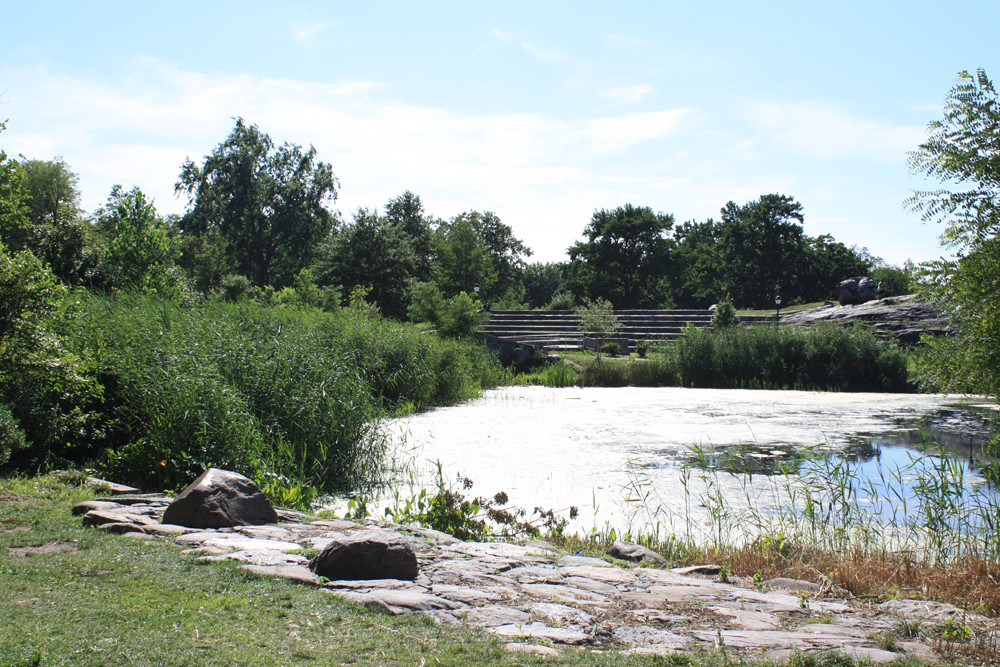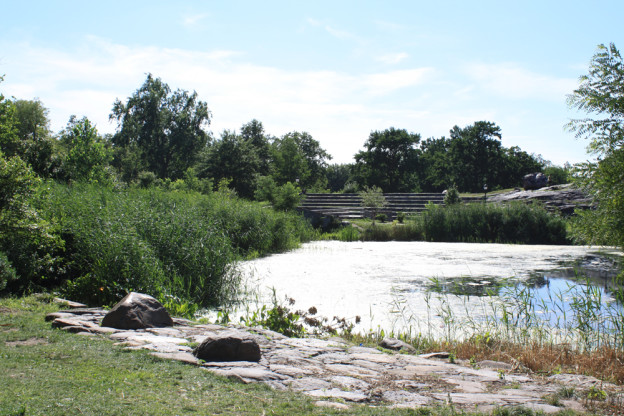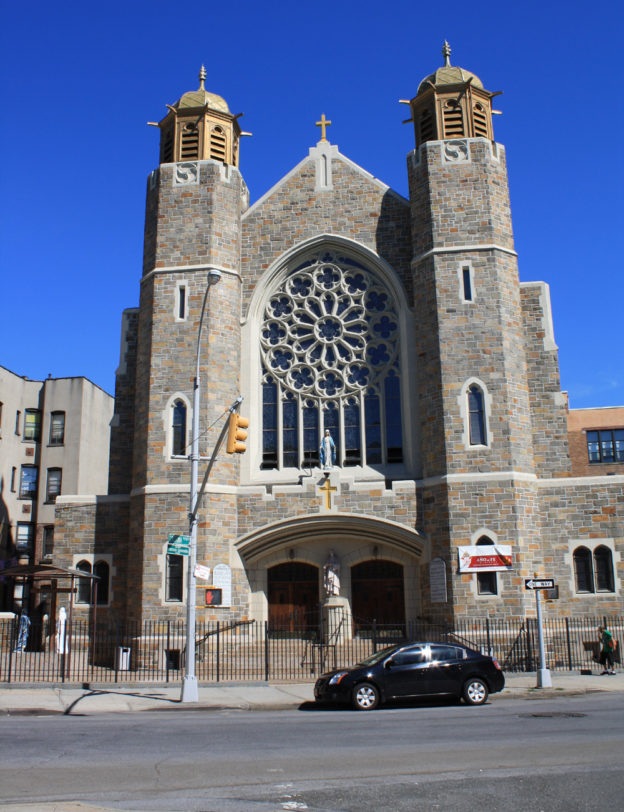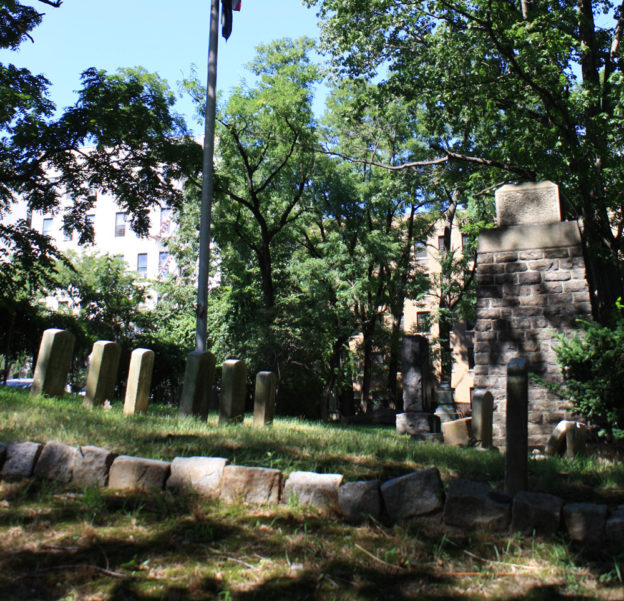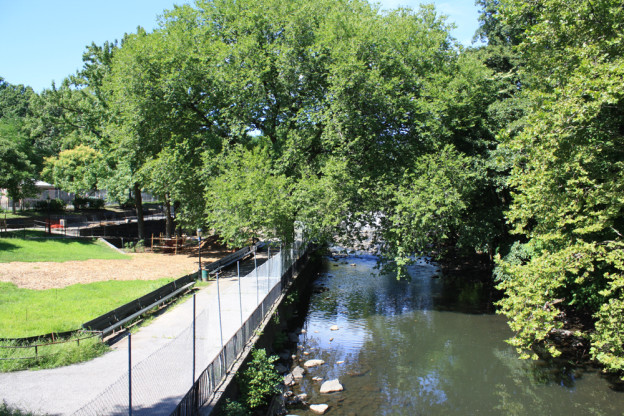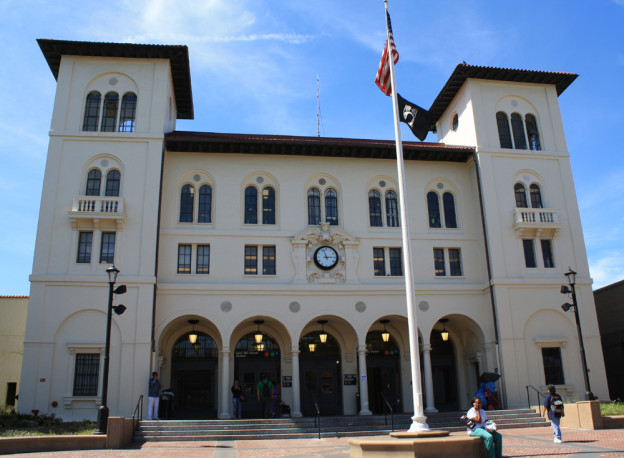1888;
Herbert Magoon, Aymar Embury II and others, 1934-36|
This park was originally part of the roughly 2,000-acre Morris estate, dating back to 1679.In 1848, Gouverneur Morris II (1813-1888) auctioned off much of his property to profit from the area’s suburbanization. This 127.5- acre parcel was sold to the Bathgate family, who owned it until 1888, when it was acquired by the City. Due to plans for numerous athletic facilities in the park, it was named after Croton, the ancient Greek city that was home to many Olympic champions. Indian Lake is a scenic highlight that the Bathgate family allowed the public to use for recreation before the property became public. Concrete walls and paths around the lake were installed in 1914. The boathouse was built in the 1940s under Parks Commissioner Robert Moses after a concession stand burned down on the site. Across the lake is a stone bridge and amphitheater, which was unveiled in 2009. The Crotona Play Center, a bathhouse and swimming pool at the park’s western edge, was constructed in the Art Deco style under the Works Progress Administration. It features a monumental arched brick entry with two square towers topped with glass-block skylights and an interior open-air courtyard. The Crotona Play Center was designated a New York CIty Individual and interior landmark in 2007.
1910;
c. 1925|
The Crotona Parkway Malls, between Crotona Parkway and Southern Boulevard, lend a pleasing atmosphere to the parkway. The City acquired the land for Crotona Parkway in 1888 to connect Crotona Park and Bronx Park. Southern Boulevard dates back to the 1870s, when it opened as a grand thoroughfare from East 133rd Street and Third Avenue to present-day Kazimiroff Boulevard. The pink granite obelisk at East Tremont Avenue is a memorial to the 87 people who lost their lives in a fire that destroyed the Happy Land Social Club across the street on March 20, 1990. At Fairmount Place is St. Thomas Aquinas Roman Catholic Church, whose Gothic Revival building lends elegance to this stretch of the parkway.
980 East 180th Street;
1905|
The congregation of this church dates back to 1815, when some of the roughly 300 inhabitants of West Farms Village formed the First Presbyterian Church. This is the church’s second building, funded by trustee Charles Bathgate Beck in memory of his mother. The Gothic Revival stone building features rectangular arrowslit openings that evoke a medieval castle. Its large, imposing terra-cotta-clad tower features a mansard roof with dormer windows and an ornate weathervane.
East 180th Street and Bryant Avenue|
On East 180th Street is a nearly 200 year-old cemetery. The oldest public veteran’s burial ground in The Bronx, this roughly 2/3-acre plot contains 40 graves of soldiers who fought in four American wars: the War of 1812, the Civil War, the Spanish-American War and World War I. Founded by John Butler for a private burial, the Butler family owned it until the City took possession in 1954. The bronze statue of a Union Army soldier was erected in 1909. The plot is named after its location in what was then called West Farms Village, established in 1663. Street. The cemetery was designated a New York CIty Individual Landmark in 1967.
Inside River Park at East 180th Street and Boston Road|
River Park is within the southern tip of Bronx Park, and features this beautiful 13-foot waterfall. The falls were first modified into a dam to power mills along the river by William Richardson shortly after 1680. Later, some of the mills were owned and operated by the DeLancey family, Huguenots (French Protestants) who settled in New York in 1686. James DeLancey (1746-1804) was famously known as the “Outlaw of the Bronx” for his loyalist stance during the Revolutionary War, during which he led the “Westchester Chasseurs,” a group of Tory troops. After the war, his land was confiscated and he moved to Nova Scotia, where he became a prominent politician.
East 180th Street at Morris;
Fellheimer & Long with Allen H. Stem;
1912|
Located at the southern tip of Bronx Park, this Italian Renaissance style building was originally the administration office for the New York, Westchester and Boston Railway system. After the system went out of business in 1937, the City tied the Bronx portion of the line into the subway system. Since then, the building has served as the East 180th clock surround, which features a winged head of Mercury, the Roman god of travel. Architect Allen H. Stem simultaneously worked with Charles Reed to design Grand Central Terminal, whose grand Beaux-Arts style contrasts this Italian villa, just as midtown Manhattan’s urban environment contrasted The Bronx’s bucolic setting at that time. In 2011, the City undertook a major restoration of the building. Street station for the 2 and 5 subway lines. Of note in the center of the façade is the ornate. The Former New York, Westchester And Boston Railroad Administration Building was designated a New York CIty Individual Landmark in 1976 and is listed the State and National Register.
